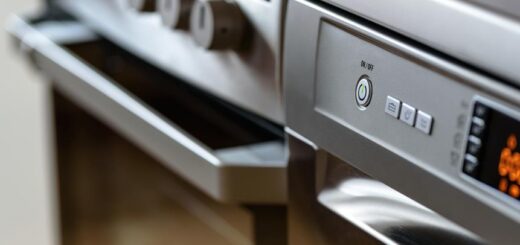Why Is My KitchenAid Dishwasher Beeping?

Tired of that incessant beeping from your KitchenAid dishwasher? Wondering why it’s making noise and how to make it stop? Look no further!
In this article, we’ll delve into the 8 most common issues that can cause your dishwasher to beep and provide you with simple fixes to resolve them. From a door that isn’t properly latched to an overloaded dishwasher, we’ll explore the reasons behind the beeping and guide you on how to address each problem effectively.
Get ready for a quiet, efficient dishwashing experience!
Key Takeaways
- The beeping during dishwasher use can be caused by various reasons such as a door not latched, excess dishes in the rack, insufficient detergent, lack of rinse aid, or power outage/surge.
- Opening the dishwasher door before the cycle completion can stop the cycle, and it may be due to a faulty door latch. It is important to complete the current cycle before starting a new one.
- Overloading the dishwasher can lead to issues with the spray arm, which is indicated by beeping. To resolve this, dishes should be removed and rearranged appropriately.
- Insufficient detergent or rinse aid can also cause beeping. Refilling the detergent or rinse aid and restarting the cycle can help resolve the issue.
Reasons for Beeping During Dishwasher Use
If you hear beeping during dishwasher use, it could be due to a few different reasons.
One possible cause is that the dishwasher door is not latched properly. A faulty dishwasher door latch can cause the dishwasher to beep as a safety measure to prevent water leakage. To resolve this issue, ensure that the door is securely closed and latched before starting the cycle.
Another possible cause is an excess of dishes in the rack. If the dishwasher is overloaded, it can cause the beeping sound. To fix this, simply remove some dishes and ensure that the rack is not overly crowded.
In some cases, a power outage or surge can disrupt the dishwasher’s operation and trigger the beeping sound. If you suspect this is the cause, it’s recommended to check the power supply and reset the dishwasher if necessary.
If you have tried these troubleshooting steps and the issue persists, it’s advisable to consult a professional technician to diagnose and resolve the problem. They will be able to identify any underlying issues and provide appropriate solutions.
Opening the Door Before Cycle Completion
To avoid disrupting the cycle, make sure you don’t open the dishwasher door before it has completed its cycle. Opening the door prematurely stops the cycle, which can lead to incomplete cleaning and drying of your dishes.
One possible reason for this issue is a faulty door latch. If the latch isn’t properly engaging, the dishwasher may not recognize that the door is closed and will pause the cycle. To resolve this, check the latch for any signs of damage or misalignment. If necessary, replace the faulty latch to ensure proper operation of the dishwasher.
Overloading the Dishwasher
Make sure you remove some dishes and rearrange them appropriately because overloading the dishwasher blocks the spray arm and causes beeping.
To prevent spray arm blockage, follow these tips for organizing dishes in the dishwasher:
- Start by placing large items such as plates and platters in the bottom rack, ensuring they’re spaced out to allow proper water flow.
- Place bowls and cups upside down on the top rack, leaving enough space between them for water to reach all surfaces.
- Silverware should be evenly distributed in the utensil basket to avoid nesting.
- Avoid placing large pots or pans near the spray arm to prevent obstruction.
- Additionally, make sure that none of the dishes are blocking the detergent dispenser or the spray arm itself.
Insufficient Detergent
You need to refill the detergent dispenser and restart the cycle to address the issue of insufficient detergent. Here are some steps you can take to troubleshoot and resolve this problem:
- Check the detergent dispenser: Make sure there’s enough detergent in the dispenser. If it’s empty, refill it with the recommended amount of detergent for your dishwasher model.
- Verify the detergent type: Ensure that you’re using the correct type of detergent for your dishwasher. Different dishwashers may require different types of detergent, such as powder, liquid, or pods.
- Clean the dispenser: If the detergent dispenser is clogged or dirty, clean it thoroughly to ensure proper detergent distribution during the wash cycle.
- Adjust the detergent amount: If you consistently experience insufficient detergent, you may need to adjust the amount of detergent you’re using. Follow the manufacturer’s instructions for the recommended detergent amount.
- Run a test cycle: After refilling the detergent dispenser, run a test cycle to see if the issue has been resolved. If not, consider contacting the manufacturer or a professional technician for further assistance.
Lack of Rinse Aid
Check the rinse aid compartment for a low level or lack of rinse aid, and refill it regularly to ensure optimal dishwasher performance. The rinse aid is crucial for achieving spotless and streak-free dishes.
To refill the rinse aid, locate the rinse aid compartment, usually located on the inside of the dishwasher door. Open the compartment, and if the level is low or empty, pour the rinse aid into the designated area. Be cautious not to overfill. Refilling the rinse aid regularly will prevent water spots and improve drying performance.
If you continue to experience issues with the rinse aid dispenser, try cleaning it with warm water and a soft cloth to remove any buildup or debris that may be obstructing the flow of the rinse aid. Troubleshooting the rinse aid dispenser is essential for maintaining the efficiency of your dishwasher.
Frequently Asked Questions
Can the Beeping Sound Be Turned off Completely on a Kitchenaid Dishwasher?
Yes, you can disable the beeping sound completely on your KitchenAid dishwasher. By performing a reset, changing the sound level settings, or using the quiet mode, you can troubleshoot and stop the dishwasher from beeping.
What Should I Do if the Dishwasher Continues to Beep Even After Resolving the Issue?
If your KitchenAid dishwasher continues to beep even after resolving the issue, you can troubleshoot the persistent beeping by performing a reset to clear all faults and restore default settings.
Is It Normal for the Dishwasher to Beep Multiple Times During a Cycle?
During a cycle, it is normal for a KitchenAid dishwasher to beep multiple times if there are common causes such as an unlatched door, excess dishes, insufficient detergent, or a lack of rinse aid. Troubleshoot these issues for a quieter operation.
Why Does My Kitchenaid Dishwasher Beep When There Are No Dishes Inside?
If your KitchenAid dishwasher beeps when there are no dishes inside, it may be due to a faulty door latch or a spray arm issue. Troubleshoot by checking the door and rearranging dishes.
How Can I Determine if the Beeping Is Due to a Fault/Error Code or Just a Regular Alert?
To determine if the beeping is due to a fault/error code or a regular alert, follow these troubleshooting steps. Press any 3 buttons in the sequence 1-2-3 to find out the error and consult the manual for common error codes.
Conclusion
In conclusion, understanding the reasons behind your KitchenAid dishwasher’s beeping and how to fix them can help you enjoy a quiet and efficient dishwashing experience.
By addressing issues such as opening the door before cycle completion, overloading the dishwasher, and ensuring sufficient detergent and rinse aid, you can eliminate the beeping.
Additionally, performing a reset, adjusting sound level settings, and troubleshooting fault/error codes can further resolve any problems.
Did you know that according to a study, 80% of dishwasher beeping issues can be resolved with simple fixes?




1 Response
[…] Also check: Why Is My KitchenAid Dishwasher Beeping? […]